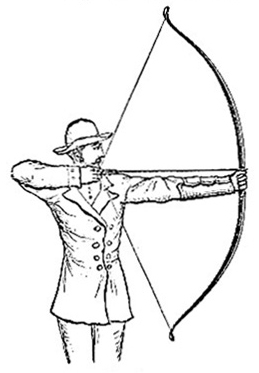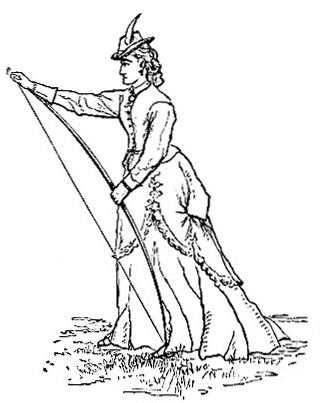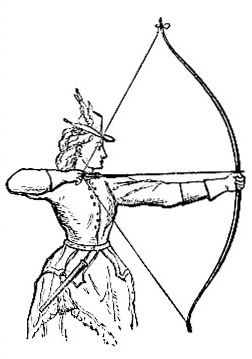(8) PRACTICAL ARCHERY - HOW TO LEARN TRADITIONAL ARCHERY
There is no "royal road" to archery, and more real progress towards proficiency in the bow may be gained in a few hours under the practical guidance of an adept in the art, than can possibly be imparted by all the treatises upon the subject that ever were written; yet for those who would master the rudiments of the science, a few words may be useful upon what have ever been considered the "five points of archery," which Ascham in his celebrated work describes as "standing, nocking, drawing, holding, and loosing."

Fig. 1
1. Roberts, in his English Bowman, remarks upon the difficulty of conveying by verbal description so accurate a representation as the pencil can give of an archer drawing his bow. It is a model of gracefulness, the attainment of which is so pointedly recommended by Ascham. Mr Ford, in his disquisition, says the "heels should be about six or eight inches apart·. The feet must be flat and firm on the ground, both equally inclining outwards from the heels, ·. the position of the feet being such that a straight line drawn from it would intersect both hells·. The knees must be perfectly straight, not bent in the slightest degree·. The weight of the body should be thrown equally on both legs·. In short, the footing must be firm, yet at the same time easy and springy, and the more natural it is the more likely it is to possess these qualities." The accompanying woodcut will best illustrate the attitude which an archer should assume.
2. To string a bow, take it by the handle in the left hand, with the flat side (or back) towards the wrist; place the horn of the under end in the hollow of the left foot; then put the palm of the right hand on the back of the upper end of the bow, below the loop of the string, with the thumb on the one side, and the forefinger bent on the other side of the bow, and with t he left hand fixed as the fulcrum. Then with the right hand press the string upwards until it reaches the notch in the horn, and the bow is strung, and should exhibit a space of about 5 ¸ inches between the string and the interior of the handle.

Fig. 2
"Honora Spencer (Mrs Sharpe), who wrote specially upon archery from a lady's point of view, in alluding to the stringing of the bow, remarks: - ÎWhilst the right wrist is pressing the bow downwards the other hand should be pulling your bow towards you, each hand with equal pressure, each hand with equal strength. At the same moment that you press and pull, you must use your first two fingers (of course of the right hand) in slipping the string into the groove intended for its receptions.' Another mode is recommended, and we are told Îto press the thumb and forefinger closely against the sides of the bow, whilst you pull smartly at the handle.' This, I believe, is the accepted method among gentlemen; but a lady has not often sufficient power in her thumb and forefinger to bend the bow and string it at the same moment; besides this, the pressing of the bow with the wrist is far more graceful for a lady. The same remark and advice apply to the unstringing of the bow, only that the string has to be slipped out of the groove. If you find after some half-dozen attempts that this method of stringing strains neither the right nor left wrist, you may safely conclude that your bow is suited to your strength.
3. The bow being now ready to receive the arrow, the archer must "nock," or place it on the string at a spot prepared for it (which should be about 3/8ths of an inch above the upper end of the handle) with the guide feather furthest from the bow, catching the string with two or three fingers, and the arrow between the first and second.
4. He must then take a firm position with his left shoulder towards the target, turning his head only from his neck, and looking over his left shoulder. He must then raise the bow with his left hand, keeping the upper end inclined one or two degrees from his body, and with his right hand draw the arrow to the level of his chin, and below his ear, to which point the arrow should always be drawn while the left hand and arm should be elevated or depressed, according to the distance to be shot, or the strength of the bow.

Fig. 3
5. When the arrow is fully drawn, dwell for a moment or two to steady the aim; then "quit" or discharge the arrow, by allowing the string to pass smoothly over the finger points without jerking. The position which a lady should assume whilst in the act of discharging her arrow is illustrated by the annexed figure the correctness of which might have been increased by the elbow of the left arm, in which there should not be the slightest bend, being held straighter.
Except for line there is no accepted theory of taking aim. Due regard must be paid to the weather. When it is calm, the archer must fix the position of the target in his vision, and experience will soon tell him how to find the line and degrees of elevation. In wind, the line and degrees must be varied to suit the conditions of the atmosphere; in a cross wind there must be an adaptation to the direction of the wind; whilst in an up and down wind more or less elevation must be taken according to the strength of the current.
The following is a summary of points well worthy of being remembered by every shooter: - Have the string straight on your bow. Always nock on the same place. Plate the arrow over the string, not between it or the bow. Do not have the arrow too tight on the string. Draw slowly and evenly. Turn your elbow a little upwards. Slant the bow a little to the right. Always draw the arrow the same length. Draw a little below the right side of the chin. Always, while drawing, keep the elbow of your right arm level with the shoulder. Keep the "point of aim" always directly in view. Look along the whole length of the arrow. Be careful to point it perfectly straight. Do not shut the left eye; yet do not aim with it. Make the left arm always that by which you change the elevation. Do not hold the bow long fully drawn. Never let the fingers of your right hand follow the string. Do not jerk, but loose smoothly. Be certain that your bow-arm does not move when loosing.
"Flight" and "clout" shooting has ceased, and "roving" is now practiced only in Britain by the two clubs previously mentioned. They use a target 3 feet in diameter, and count arrows four bow lengths from the target; the nearest arrow counts two. Shooting at butts is still practiced, the butts being from 80 to 100 feet apart; the mark is a round piece of pasteboard 4 inches in diameter. The shooting is nearly point blank. (J. SH.)
Read the rest of this article:
Archery - Table of Contents
|


